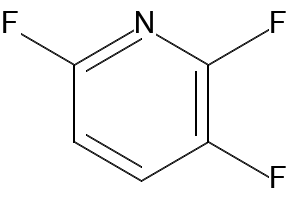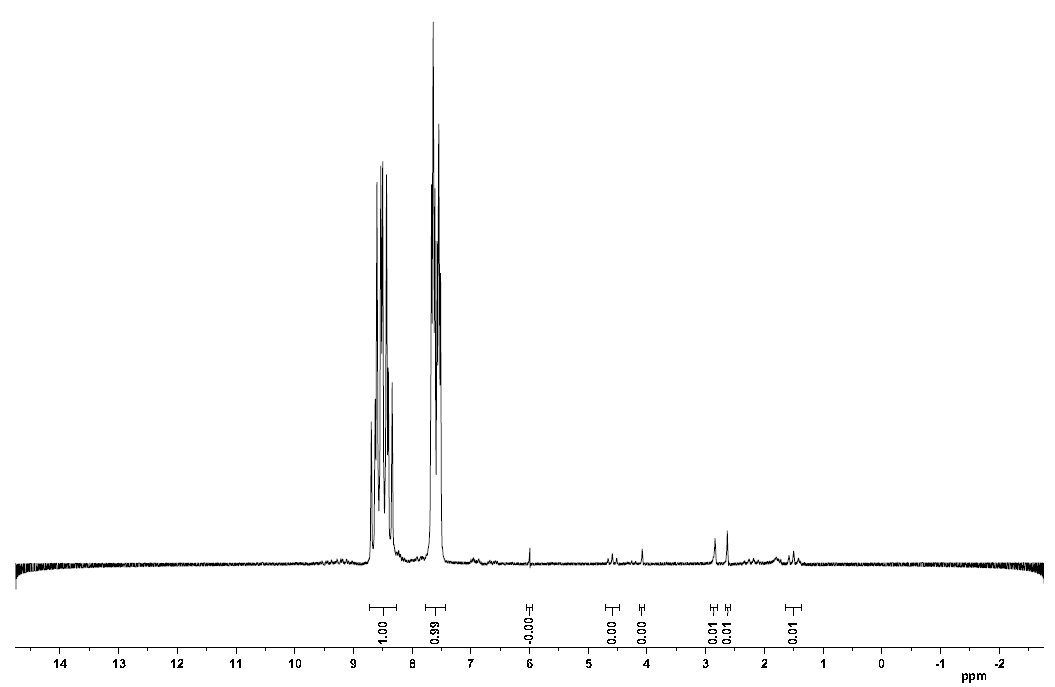2,3,6-TRIFLUOROPYRIDINE CAS#: 3512-18-3; ChemWhat Code: 7663
Identification
| Product Name | 2,3,6-TRIFLUOROPYRIDINE |
| IUPAC Name | 2,3,6-trifluoropyridine |
| Molecular Structure |  |
| CAS Registry Number | 3512-18-3 |
| EINECS Number | No data available |
| MDL Number | MFCD03001158 |
| Beilstein Registry Number | No data available |
| Synonyms | 2,3,6-trifluoropyridine, 2,3,6-trifluoro-pyridine, 2,5,6-trifluoropyridine, 2,3,6-trifluoropyridin |
| Molecular Formula | C5H2F3N |
| Molecular Weight | 133.07 |
| InChI | InChI=1S/C5H2F3N/c6-3-1-2-4(7)9-5(3)8/h1-2H |
| InChI Key | HRLIANGJWPJFKW-UHFFFAOYSA-N |
| Canonical SMILES | c1cc(nc(c1F)F)F |
| Patent Information | ||
| Patent ID | Title | Publication Date |
| US2015/18328 | THERAPEUTICALLY ACTIVE COMPOUNDS AND THEIR METHODS OF USE | 2015 |
| US3947457 | Method for preparing 2,5-dihalo- and 2,5,6-trihalopyridines | 1976 |
Physical Data
| Appearance | Colorless transparent liquid |
| Solubility | No data available |
| Flash Point | No data available |
| Refractive index | No data available |
| Sensitivity | No data available |
| Boiling Point, °C | Pressure (Boiling Point), Torr |
| 115 – 117 | |
| 118 – 119 | |
| 115 – 116 | 750 |
Spectra
| Description (NMR Spectroscopy) | Nucleus (NMR Spectroscopy) | Solvents (NMR Spectroscopy) | Temperature (NMR Spectroscopy), °C | Frequency (NMR Spectroscopy), MHz |
| Chemical shifts | 19F | benzene | 26.84 | 377 |
| COSY (Correlation Spectroscopy) | 19F,19F | benzene | 26.84 | 377 |
| Chemical shifts | 1H | CDCl3 | 400 | |
| Chemical shifts | 1H | neat (no solvent) | ||
| Chemical shifts | 1H | CCl4 | ||
| Chemical shifts | 19F |
Route of Synthesis (ROS)
| Conditions | Yield |
| With ammonium hydroxide In 1,4-dioxane at 100℃; for 12h; | 85.2% |
| With ammonium hydroxide In 1,4-dioxane at 100℃; for 12h; | 85.2% |
| With ammonia In water at 100℃; for 3h; | 74% |
Safety and Hazards
| Pictogram(s) |    |
| Signal | Danger |
| GHS Hazard Statements | H226 (100%): Flammable liquid and vapor [Warning Flammable liquids] H314 (16.67%): Causes severe skin burns and eye damage [Danger Skin corrosion/irritation] H315 (83.33%): Causes skin irritation [Warning Skin corrosion/irritation] H319 (83.33%): Causes serious eye irritation [Warning Serious eye damage/eye irritation] H335 (83.33%): May cause respiratory irritation [Warning Specific target organ toxicity, single exposure; Respiratory tract irritation] Information may vary between notifications depending on impurities, additives, and other factors. |
| Precautionary Statement Codes | P210, P233, P240, P241, P242, P243, P260, P261, P264, P271, P280, P301+P330+P331, P302+P352, P303+P361+P353, P304+P340, P305+P351+P338, P310, P312, P321, P332+P313, P337+P313, P362, P363, P370+P378, P403+P233, P403+P235, P405, and P501 (The corresponding statement to each P-code can be found at the GHS Classification page.) |
Other Data
| Transportation | Not Classified |
| Under the room temperature and away from light | |
| HS Code | No data available |
| Storage | Under the room temperature and away from light |
| Shelf Life | 1 year |
| Market Price | USD |
| Druglikeness | |
| Lipinski rules component | |
| Molecular Weight | 133.073 |
| logP | 1.431 |
| HBA | 1 |
| HBD | 0 |
| Matching Lipinski Rules | 4 |
| Veber rules component | |
| Polar Surface Area (PSA) | 12.89 |
| Rotatable Bond (RotB) | 0 |
| Matching Veber Rules | 2 |
| Use Pattern |
| 2,3,6-TRIFLUOROPYRIDINE CAS#: 3512-18-3 is often used as a pharmaceutical intermediate |
| 2,3,6-TRIFLUOROPYRIDINE CAS#: 3512-18-3 also be used to prepare small molecule inhibitors of MALT1. |
Buy Reagent | |
| No reagent supplier? | Send quick inquiry to ChemWhat |
| Want to be listed here as a reagent supplier? (Paid service) | Click here to contact ChemWhat |
Approved Manufacturers | |
| Caming Pharmaceutical Ltd | http://www.caming.com/ |
| Want to be listed as an approved manufacturer (Requires approvement)? | Please download and fill out this form and send back to approved-manufacturers@chemwhat.com |
Other Suppliers | |
| Watson International Limited | Visit Watson Official Website |
Contact Us for Other Help | |
| Contact us for other information or services | Click here to contact ChemWhat |



